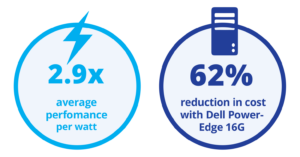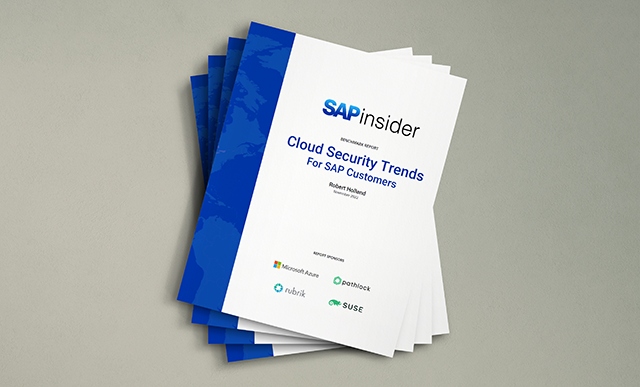From Cloud to Gem: Powering Hybrid SAP with Dell PowerEdge servers on Intel Sapphire Rapids
Key Takeaways
⇨ Hybrid deployments need updated on-prem servers for HANA migration; Dell and Intel provide a robust solution.
⇨ On-premises hosting is crucial alongside the cloud for SAP due to data control and performance.
⇨ Dell PowerEdge 16G servers with Intel chips offer superior performance, scalability, and cost-effectiveness for SAP modernization.
Infrastructure modernization inside hybrid deployments requires an onprem server refresh for HANA – S/4HANA migration. One solution comes from a powerful combination of Dell servers and “sparkling” Intel chips.
What connects Dell Technologies, Intel® and SAP? The obvious answer: they are three titans of tech. But with their three distinctly different areas of technology propositions, it may be less obvious what their combined forces can offer enterprises when it comes to infrastructure modernization. Modernization can often mean a move to the cloud. But as appealing as cloud is, there’s a central reason why we talk about hybrid deployments being the mainstay of any sturdy enterprise IT stack and architecture. In reality, organizations will be looking to migrate some of their current workloads to the cloud, especially as the deadline for SAP HANA-S/4HANA migration looms. But it’s also important to refresh to new on-premises server hardware and build a more unified approach to IT modernization at both ends of the data workflow chain.
Why cloud isn’t everything
Cloud isn’t everything, and there are compelling reasons to remain on-premises with a proportion of an organization’s SAP environment. Server performance, speed and latency for specific mission-critical applications will always be a factor, but the presence of data sovereignty and regulatory requirements will always be close by as well. SAP HANA is an extremely high-performance technology from its base foundations which at inception were precision-engineered to align to the Intel chipset. But processing big data on SAP HANA goes slow if server performance is less than excellent, and this holds for both public cloud and on-premises. Creating a hybrid performance backbone using Dell PowerEdge 16G servers with 4th Gen Intel® Xeon® Scalable processors – also known as Sapphire Rapids – is one way of grasping total system agility for the short, medium and long term, and improving the performance of data analytics for your enterprise. In other words, genuine modernization is no longer pie-in-the-sky thinking, but something tangible and firm.
Workload placement attainment
Deciding which workloads will reside on-premises and which may be suitable for cloud is a factor of a number of key rationales. Some workload locations will be determined by their need to adhere to data governance mandates that specify in-country data locality; we can see on-premises servers shouldering many of these deployments. Similarly, on-premises will generally offer higher Recovery Time Objective (RTO) rankings, depending on the nature of the applications being run. As well as carbon-neutral considerations, a major concern for Cloud Service Providers and customers alike is the issue of security responsibilities, which can simply never be handed to a third party. As such, on-premises remains the only logical choice. Regarding systems management, location decisions can only be made when we understand each workload’s unique performance requirements, calibration criteria and data handling. Extending this thought, some workloads will fail to benefit from the economics of cloud computing – either because they are too static to cloud’s webscale breadth and scope for service flexibility, or simply because data upload/ download ingress/egress fees are overly expensive.
Six server selection schemes
There are more than a handful of server selection criteria that organizations should consider as they look to build their IT infrastructure to take full advantage of all the upgrades and enhancements that SAP’s database technology and new generation of apps and solutions have to offer.

1 PERFORMANCE
Performance will always be the most important consideration for any technology deployment. To deliver on its performance prowess, SAP HANA requires high processing power, large memory capacity and fast storage. Benchmarks are key to finding the best solution for your business, and mid-size customers may want to look at the SAP Business Warehouse (BWH) performance benchmarks. Here the Dell PowerEdge R760, featuring the 4th Gen Intel Xeon Scalable processor, can be seen to outperform its predecessor, the Power- Edge R750. PowerEdge R760 servers are 2-socket systems that break performance records for SAP HANA workloads. This means they can handle more data from more enterprise applications in larger amounts and in less time – meaning the power to make faster business decisions, employ AI and to gain new and unique insights into customer behavior patterns. The PowerEdge R760 server outperforms all other benchmarked 2-socket servers, but it also outperforms the tested 4-socket and 8-socket servers that have twice or four times the number of processors. Some of this can be explained by how the servers use the chip “magic” of Intel’s Sapphire Rapids, while the 4-socket and 8-socket servers are using previous generations of Intel Xeon Scalable processors. But even when comparing these results to those of other 4th Gen Intel Xeon processor–powered servers, the Dell system still shines bright – like a gleaming sapphire gemstone, one could say.
2 SCALABILITY
Any business of any size goes through development cycles and change, most of which its owners will naturally hope lead to growth. As an organization’s business needs change, workloads alter and data volumes increase. This means management will want to consider servers that can scale up SAP HANA resource requirements – such as CPU power, memory, storage, networking or wider connectivity – without compromising performance, availability, or security. This is also the point at which the business may want to consider the flexibility and ease of adding or removing resources, as well as the cost implementations of scaling. Servers like Dell PowerEdge with Intel Sapphire Rapids processors are designed to give your organization faster performance and easy scalability. They also include the latest enhancements to ensure hassle-free deployment and end-to-end security for a smooth and safe refresh.
3 RESILIENCE SAP
SAP landscapes are typically critical for business operations. This means that any downtime can result in significant operational disruptions and financial losses. In the pursuit of resilience to underpin business excellence, a business should identify solutions that provide comprehensive monitoring and management tools that can simplify system administration, optimize performance and facilitate proactive troubleshooting. Management therefore can prioritize the use of servers such as Dell PowerEdge 16G offerings, which are capable of ensuring high availability and disaster recovery for SAP HANA, such as redundant components, backup and restore capabilities, fault tolerance and failover mechanisms.
4 SECURITY SAP HANA
SAP stores and processes sensitive business and customer data that needs to be protected from unauthorized access, modification, or loss. Working together, business and technology managers should look for servers that can provide comprehensive security features such as encryption, authentication, authorization, auditing, firewalls, and antivirus. With Dell PowerEdge Cyber Resilient Architecture, robust layers of security are included, providing for a foundation for the critical elements of a Zero Trust environment.

5 SUSTAINABILITY
Choosing servers that are energy-efficient, low-carbon, and have a long lifespan can not only help reduce the environmental impact of running SAP HANA applications but can help your organization achieve environmental, social, and governance goals. Look for International Organization for Standardization (ISO) Type 1 labels, often called eco-labels, to determine the environmental credentials for solutions. Dell PowerEdge servers with Intel Sapphire Rapids processors are designed with sustainability in mind, helping organizations to achieve a 2.9x average performance per watt efficient improvement for targeted workloads, compared to previous generations.
6 COST
SAP HANA is a significant investment that can deliver great value for any business. However, organizations should also consider the overall cost of infrastructure, including initial acquisition cost, ongoing maintenance cost, power and cooling cost and required licensing expenditure. Replacing four-year old servers can significantly lower total cost of ownership. For example, refreshing previous-gen Dell PowerEdge servers with Dell Power- Edge 16G servers can potentially reduce TCO 62%.
The “edge” of Dell PowerEdge
Overall, we can say that SAP modernization is not a one-size-fits-all, point-andclick endeavor that comes “out of the box”. There are aspects to consider of compliance, security, performance, management capabilities, and availability. Meanwhile, cost of cloud versus on-prem environments always impact each organization’s IT stack, data estate and workload cycles in different ways. While cloud-based deployments have gained momentum, on-premises deployments still offer tangible and important benefits.
This naturally means that Dell Power- Edge 16G servers with Intel Sapphire Rapids processors remain a popular choice for organizations with requirements related to compliance, data control, performance and cost.
The propositions improve core performance metrics for data analytics, meaning businesses can more competently scale upwards and outwards when new opportunities arise. New lines of business can be run concurrent to existing operations and new markets can be explored and potentially exploited at speed.
Why? Because a faster IT stack engine with fast-running SAP HANA workloads improves software team experiences. This in turn directly translates into better user experiences and customer experiences.
And as Dell PowerEdge servers with Intel Sapphire Rapids processors boast formidable capacity, organizations can consolidate their IT stack onto a smaller footprint with faster memory performance to make information access easier, more fluid and faster. At the price-performance ratio on offer from Dell, they are quite simply a better bang for the customer’s buck.
In other words, utilizing this technological sort of gem won’t cost organizations the sky nor the Earth – and the results will come faster than a slow-moving cloud.









